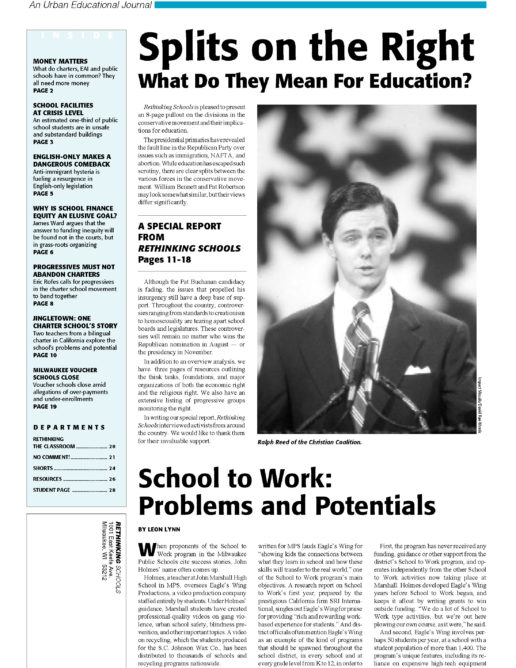Thompson Undercuts Finance Equity
If you live in Elmbrook or one of the other property-rich Wisconsin school districts, your children’s chances for a well-funded education just got better, thanks to a change in the formula that distributes state education funds.
Gov. Tommy Thompson proposed, and the legislature passed, a property tax relief plan last year that increases the state’s share of public school funding from less than half to two-thirds of school costs. Because the legislation also created a new funding formula, inequities were increased between affluent and poorer school districts, according to an analysis by the Associated Press.
The new formula added a third category of aid that provides money even to the most property-rich districts. Thompson rationalized this approach on the grounds that the main purpose of the legislation was to help taxpayers and reduce property taxes, not to help equalize school funding.
The change will pump $473 million into the school districts of Assembly Republicans, $136 million more than Democratic districts will receive, according to the AP analysis. It will particularly benefit rich Republican suburban districts that already spend a lot on schools. The ten richest districts, for example, will have increases ranging from 25% to 66%, according to the report. Poorer districts, represented primarily by Democrats, lose under the plan. The ten districts with the lowest property values will have either a loss or a minimal increase, ranging from a nine-tenths of a percent loss to a seven-tenths of a percent increase, AP reported.
In the Milwaukee metropolitan area, the changes run from a low of 18% in Cudahy to a high of 148% in Greenfield.
Under the new plan, local property taxes must be reduced, with the loss in funds offset by $1.2 billion of increased state funding. While media reports give the impression that poorer school districts are finally getting some assistance, this is not the case. For example, Milwaukee will receive a 20% increase in state aid in 1996-97, while the statewide average is 55% and the suburban average is 58% (based on per-pupil funding). In addition, revenue limits were made permanent and schools districts will be held to a per pupil increase of $206 for 1996-97. The increase is the same for all districts, and thus will help lock in inequities. Furthermore, the increase must cover all costs, including increased salaries, rises in health insurance and benefits, and maintenance costs such as heating.
The impact of the revenue limits and the new funding formula means there are insufficient dollars available in low-property-value districts like Milwaukee, leading to budget cuts through program cuts or layoffs.
The Associated Press study has increased the impetus of a lawsuit filed in Dane County Circuit Court last October by the Association for Equity in Funding, composed of over 100 school districts, primarily in urban and rural areas. The suit challenges the constitutionality of the state school finance system, and the trial is expected to begin next year.

